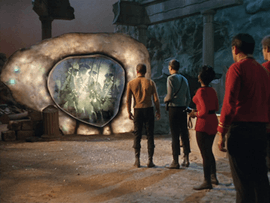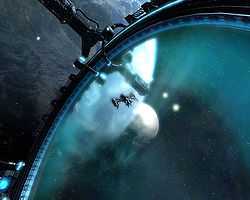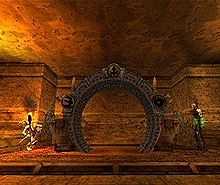Portals in fiction

A portal in science fiction and fantasy is a technological or magical doorway that connects two distant locations separated by spacetime. It usually consists of two or more gateways, with an object entering one gateway leaving via the other instantaneously.
Places that a portal will link to include a different spot in the same universe (in which case it might be an alternative for teleportation); a parallel world (inter-dimensional portal); the past or the future (time portal); and other planes of existence, such as heaven, hell or other afterworlds. A parallel world, such as C. S. Lewis's Wood between the Worlds in his Chronicles of Narnia, may exist solely to contain multiple portals, perhaps to every parallel world in existence.
Portals are similar to the cosmological concept of a wormhole, and some portals work using wormholes.
Use


Portals are often used in science fiction to move protagonists into new territory. In video games the concept is often used to allow the player to cover territory that has already been explored very quickly. A related book plot that is commonly used is the struggle to get to the opposite end of a new gate for the first time, before it can be used.
Film and television
In film and television, a portal is often portrayed using a ripple effect.
- Star Trek: The Original Series: One of the earliest examples is the Guardian of Forever, in Star Trek. The device could open a spacetime portal to any point in history on any world in the universe. It was ring-shaped, with a watery "event horizon". This device was introduced in the Star Trek: The Original Series episode "The City on the Edge of Forever" in 1967.
Other examples of portals include:
- Buck Rogers in the 25th Century (TV series): Portals appeared in the series Buck Rogers in the 25th Century (1979–1981), where interstellar travel was facilitated by a network of portals.
- Cowboy Bebop: In the anime Cowboy Bebop, hyperspace gates allow for faster—though not instantaneous—travel between the planets and colonies of our solar system.
- Doraemon: A more lighthearted use of portals can be found in the Japanese comic and anime series Doraemon, where the Anywhere Door is used to travel from any point to another. This door looks like and operates like an ordinary household door.
- The Final Countdown (film): In the movie The Final Countdown, the aircraft carrier USS Nimitz is transported via a portal to 1941, where its Captain must decide whether to intervene in the Pearl Harbor attack.
- He-Man and the Masters of the Universe: In the cartoon series He-Man and the Masters of the Universe and She-Ra: Princess of Power the characters are able to travel trough time and space by using magic portals. They can be openend by characters with magic abilities and are usually of a yellow, gleeming, colour. Sometimes they can have a pink or purple appearance. If they allow instant travelling is inconsistent displayed: Mostly, the user of such a portal is able to get from one place to another in just a few moments. In other cases (so displayed in the She-Ra-Episode "Darksmoke and Fire"), the user is shown travelling trough a separate dimension and his or her way can be changed.
- Howl's Moving Castle: In the Hayao Miyazaki film Howl's Moving Castle, based on the novel by Diana Wynne Jones, Howl's castle has a door with a four color dial above it, and each color setting causes a different location to appear on the other side of the door, only one of which is immediately outside the castle.
- Jackie Chan Adventures: In the cartoon series Jackie Chan Adventures, eight demons were sealed away using portals to trap each of them in a different realm. The portals could be opened again, and all were. The demons were released but later sealed back into the netherworld. A spell was used on each portal to seal it forever, ensuring that the demons could never escape again.
- Jak and Daxter: The warp gates in Jak and Daxter, which are rings containing a rippling blue substance used for transportation.
- Lost in Space (film): The 1998 film Lost in Space featured a space-bound hypergate system. The premise of the film is that the Robinson family will pilot a spaceship to Alpha Centauri, in order to complete construction of another hypergate there, which will allow instantaneous travel between Earth and Alpha Centauri.
- Monsters, Inc.: The animated film Monsters, Inc. involved portals that open into children's closets. This enabled the inhabitants of the monster world to enter children's bedrooms and cause them to scream. Children's screams are the power source of the monster world, which are siphoned through the portal into containers for refinement. Each portal is an exact replica of a child's wooden closet door in a metal frame, allowing a monster to enter that child's room. Some portals have metal doors and open to counterparts in remote locations in the human world. The finale has a wild chase through a massive gallery of closet door portals, causing jumps between places such as Paris, Japan and Tahiti.
- ReBoot: A portal in ReBoot, created by the villainous character Megabyte, displays a rippling event horizon.
- Starcraft (series): The StarCraft series features warp gates that are similar in style and function.
- Stargate Franchise: The Stargate franchise uses portals as one of the primary methods of travel between planets. Large rings are placed on, or in orbit around planets throughout the universe. When the travelers "dial" the address of their destination, a wormhole is formed between the two portal gates.[1]
- Star Trek: The Next Generation: Star Trek also showed devices called "Iconian gateways" with angular frames and ripple effects such as the one in the Star Trek: The Next Generation episode "Contagion".
- Star Trek: Voyager: In Star Trek: Voyager and the game Star Trek: Armada II, the Borg have a technology known as the transwarp conduit. The aperture of the conduit at the transwarp hub resembles the event horizon of a stargate crossed with the wormhole effect created by the stargate.
- Teenage Mutant Ninja Turtles (1987 TV series): The 1987 Teenage Mutant Ninja Turtles cartoon, where the dimensional portals allow fast transportation between distant locations, and some portals are even used to travel in time. The portals are connected to machines and often look like a pulsating light in different colors.
- Transformers: In Transformers, the Decepticons built the Space Bridge, which serves a similar purpose. A large round ring built on Earth (lying flat) would create a subspace tunnel to a destination tower on Cybertron. One key difference in function was that matter was not broken apart for transport.
- Gravity Falls: In Gravity Falls, Dipper and Mabel's Great Uncle Stan constructed a portal underneath the Mystery Shack. It was used to bring his twin brother back from an unknown location.
Literature
In his Hyperion Cantos novel series, Dan Simmons imagines a network of portals called "farcasters" which connect most human-inhabited planets. The form these portals take can vary, and they may be opaque, completely transparent, or semi-transparent. The completely transparent variety is very commonly used and effectively turns all connected places into one giant WorldWeb where distance becomes almost meaningless. Some of the more opulent occupants may have houses where each room is built on a different planet, and some rooms themselves may be partially built in several different physical locations but be joined by farcaster portals to form one complete room.
Stephen Robinett's book Stargate[2] (1976) revolves around the corporate side of building extra-dimensional and/or transportational stargates. In the novel, the stargate is given the name Jenson Gate, after the fictional company that builds it. Andre Norton's 1958 novel Star Gate may have been the first to use that term for such portals. The plot of Robert A. Heinlein's Tunnel in the Sky (1955) uses a portal. Raymond Jones' Man of Two Worlds (aka Renaissance) (1944) employs a portal that turns out to be a fraud.[3]
The Shi'ar, an extraterrestrial race introduced by Marvel Comics in 1976, also utilize a network of stargates. The Shi'ar utilize both planet-based stargates (for personal travel) and enormous space-based versions (equivalent to the Ori supergate and used as portals for spaceships), though both are usually depicted without any physical structure to contain the wormhole. They are used for travel across great distances.
Since the introduction of the stargate on the big screen other authors have referenced the stargate device. Authors Lynn Picknett and Clive Prince also write of The Stargate Conspiracy: The Truth About Extraterrestrial Life and the Mysteries of Ancient Egypt. The book details an alternative theory links the term stargate with Egypt's past: Either the pyramid itself is a gateway to the stars (because of the shafts pointing to a star) or a construction of Heaven on Earth based on geographical location of the great and outlying pyramids (see: Orion).
Games

Stargate-like devices, referred to as warp zones, are abundant in video games, as they can be used to split a game neatly into levels. The video games Primal and Turok the Dinosaur Hunter feature gateways allowing instantaneous travel between locations to this effect. In Metroid Prime 2: Echoes, a number of ring-shaped dimensional portals allow the main character to travel between Light and Dark versions of the planet Aether. In the game EVE Online, a large object called a "stargate" lets the player travel between solar systems, and in Homeworld 2, Hyperspace Gates serve as the centerpiece of one of the game's final missions, in which massive rings create wormholes capable of transporting matter great distances. In Super Mario 64 and its follow up, Super Mario Sunshine, various paintings and warp pipes lead to levels, all connected by a bigger level that houses these portals. Portals are used frequently throughout the Spyro (series), with each individual level, or world, separated by portals, allowing for loading screens which do not damage the games immersion.
In "Bioshock Infinite", Elizabeth is able to open up portals ("Tear's") from another period of time either future or past, in an alternate dimension of their world.
In the Half Life franchise, Combine forces use portals to travel to Earth from Xen, a parallel plane of existence.
In Command and Conquer 3: Tiberium Wars, the alien race Scrin uses portals to transport their armies onto and across the battlefields. The description of their Gravity Stabilizer states that the structure compensates for Earth's intense gravity and magnetic field, "allowing Alien spacecraft to execute short-range teleportation jumps directly to the battlefield".
Portals are common in MMORPGs. In RuneScape, portals can be used domestically. Players can install portal chambers in their houses that link to different cities in the world, allowing free transport to these places for both them and any visitors to their houses.[4] In World of Warcraft, mages can summon portals that can teleport the mages and their group members to various cities.
In the augmented reality game Ingress portals are placed at sculptures, statues, and other public art, unique businesses, and historically and architecturally significant buildings and the like, but serve as nodes in the game mechanics (see graph theory) without any transportation function.
The game Portal and its sequel, Portal 2 created by Valve Corporation features a portal-creating device as a central game mechanic which is used to solve puzzles and reach otherwise-inaccessible destinations. The portals are depicted with few special visual effects; instead, they are shown as representations of the destination, bordered by blue or orange particle effects. In the video game Half-Life, portals are displayed as glowing balls of energy which instantly teleport the user to an inversely colored exit point.
In the game Minecraft, it is possible to build a portal to an alternate hell-like dimension called "The Nether".[5][6] It is assessed by making a frame of obsidian blocks, with a 3×2 rectangle in the centre, then setting it on fire using any object that can make fire. When lit, the frame will be filled with blocks resembling whirlpools. If a player stands in the portal for long enough, he or she will be transported to "The Nether," an alternate in-game universe consisting of mainly caves, lava, Nether Fortresses, mushrooms, neutral zombie pigmen, Magma-slime creatures, tall black "wither skeletons", and fire shooting "Ghasts" and "Blazes". Another kind of portal in "Minecraft" is the End Portal, which is rare portal found only 3 times throughout the world. The players use "Eyes of Ender" to find the End Portal, and places one Eye of Ender in each frame block (if not already there). When completed; and then jumped into, the Player will go the "The End", filled with mobs called "Enderman". The only way out of The End is to either get killed or kill the Ender Dragon, which will open a portal back to The Overworld.
The role of a portal serves the tunnel network of GLA in the game Command and Conquer Generals. This is a building that can garrison some units. These units can exit from every tunnel network of their base without any relay. It is supposed that they travel underground with relatively high velocities, but they seem to be teleported.
See also
References
- ↑ Stargate - StargateWiki
- ↑ Robinett, Stephen (1976). Stargate. Signet. ISBN 978-0-451-07757-8.
- ↑ Jones, Raymond F. Man of Two Worlds, Street and Smith Publications, Inc., 1944. ISBN 978-1-4344-6691-4
- ↑ "Construction - Portal Chamber". RuneScape Knowledge Base. Jagex Ltd. Retrieved 2009-10-15.
- ↑ Meer, Alec. "Minecraft Review". Eurogame. Retrieved 30 April 2013.
- ↑ Francis, Tom. "A clearer look at Minecraft’s new hell dimension". PC Gamer. Retrieved 30 April 2013.